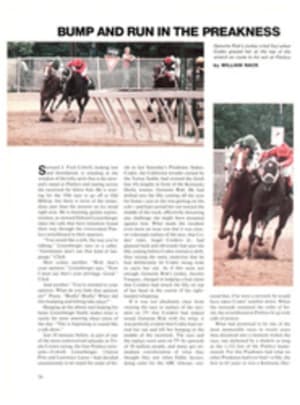
FOR THE UPRIGHT ANGLER, THE PROPER FOOTWEAR IS NEEDED TO WADE RIGHT IN
Most trout or steelhead fishermen will tell you that wading is one of the keenest pleasures of their sport. They speak eloquently of feeling the gentle strength of the river, of the subtle sounds and colors of its current, of the exhilaration that comes from gliding gracefully across a broken stretch of bright water sparkling in the sunshine.
Like most fishermen, they are probably lying. The truth is that while wading they are nearly always on the thin edge of panic, shivering from the icy flow and their own rising fears, stumbling from one hidden slippery boulder to the next, wondering how they ever got themselves into such a predicament. But their exhilaration is real enough; it comes from getting out of the river alive.
Why bother wading in the first place? Because steelhead, large trout and other river-dwelling sport fish don't always lie close to the riverbank or even within reach from shallow water. To approach them properly with a fly or lure may require considerable wading in deep, difficult water.
It looks easy enough, but that's only because the hazards aren't usually visible. Rocks on river bottoms acquire thin coats of algae that make them slicker than a Southern California used-car salesman, and currents always are stronger than they look. Some streams have more algae growth than others, which means Slicker rocks, borne have a steeper gradient, which means stronger flows. Small streams generally are pretty safe; they may have slick rocks but there's hardly enough water to drown in. Rivers can frighten you, get you soaking wet, knock you around, bruise you—even kill you.
Streams with lots of algae-covered ledge rock are very hazardous, and perhaps the ultimate test is a big winter steelhead river like Washington's Skagit, where the water temperature isn't much above freezing and the rocks are slick all year long. Even with insulated waders, one's legs grow numb in such water, making it more difficult to cope with the strong winter flow and the slippery, broken bottom. Wading in such a river is a test of agility, endurance and skill.
Over the years, fishermen have spent lots of time and effort trying to improve wading gear to maximize comfort and minimize exposure to cold water. Nowadays they use boot-foot or stocking-foot waders or hip boots made of various lightweight materials, or simply "wade wet." Hip boots are good only for shallower streams. Wading wet, which usually means wearing jeans and tennis shoes, is O.K. if you're less than middle-aged, lack a history of football-damaged knees and fish only on warm summer days. That leaves waders, which extend above the waist and are held up by a belt secured around the outside.
Boot-foot waders have a sturdy pair of boots bonded to the legs. Stocking-foot models are just what the name implies; they have soft, stocking-like feet, and wading shoes must be worn over them to prevent punctures and protect the feet from stone bruises.
But waders of any kind aren't much good if you can't stay upright in them, so fishermen have tried a lot of different things on the bottoms of their feet in hope of gaining better traction. Probably the most common of these traction devices are the rubber cleats many manufacturers mold into the soles of boot-foot waders and hip boots. These are good for digging clams on a sandy beach, but not for much else. Among serious fishermen, felt soles are much more popular. They provide surprisingly good traction on algae-slickened rocks.
The trouble with felt is that it's always either wearing out or coming unglued from the sole of the boot. It's also especially vulnerable to sharp rocks. The Lower Deschutes River in Oregon, for example, flows over a bed of basalt rocks with edges sharp enough to shave with. In only four days of fishing on the Deschutes. I once wore out two brand-new sets of felts: the razor-sharp rocks cut them to pieces.
Some fishermen use indoor-outdoor carpet as a substitute for felt. Odd-shaped remnants of it often cost less than felt, and a standard-sized carpet sample is large enough for a couple of "reshoeings," unless you have exceptionally large feet. It's simple enough to trace a pattern from your boot on the carpet, cut it out and glue it on. Carpet provides traction equal to that of felt, but, also like felt, it tends to wear out quickly and come unstuck.
Metal studs, or lugs, wear longer than felt or carpet and provide better traction by cutting through layers of algae to grip the underlying rock. Their main disadvantage is that they are noisy; to the fish, a studded angler must sound like the Pittsburgh Steelers clattering down the tunnel to the playing field. Still, anglers who fish often in big, dangerous rivers swear by studs, and they are especially popular with steelhead fishermen in the Pacific Northwest.
There are several kinds of metal studs to choose from. One manufacturer turns out rubber sandals with metal studs jutting from the soles. Called Korkers, they were originally developed for longshoremen who work on slippery docks and ship decks, but they caught on quickly with anglers. Put on over a pair of boot-foot waders or wading shoes and secured with hefty nylon laces, they provide such good traction that it's easy for a fisherman to grow overconfident and wade where he shouldn't. Another drawback is that they can be sucked right off a fisherman's feet if he's wading in very soft mud or silt—sometimes without his even knowing it.
Another metal traction device, called Stream Cleats, consists of rectangular aluminum cleats arranged in zigzag rows on felt soles that are attached to heavy-duty-rubber overshoes. The overshoes may be slipped over regular wading shoes; despite the absence of laces, they stay on relatively well. Orvis manufactures felt-soled waders prefitted with hexagonal metal lugs that also provide excellent traction. And for do-it-yourselfers, there are Rock Grabbers, felt soles fitted with small aluminum studs that may be glued to the bottom of wading shoes or boot-foot waders.
With such elaborate gear, it would seem anglers should be able to wade safely just about anywhere, maybe even walk up the sides of buildings. But it's easy to underestimate the power of a river, and even the most careful, experienced wader with the best equipment can get into trouble. Usually it happens so quickly there's no time to react: one moment you're wading comfortably and enjoying yourself; the next moment the river is carrying you off.
There's a tendency to panic and do the wrong thing in such situations. The icy shock of water pouring into your waders tends to add to your feeling of desperation and provokes a natural urge to start thrashing around.
But you can't fight a river, so the best advice is to join it. Once the current has got you, relax, hold still and try to keep yourself in a more or less upright position. Dog-paddle, if necessary, but don't kick; the flow will hold you up. Then all you do is wait for the river to sweep you back into shallow water or within reach of a low-hanging branch. The river may even stand you back on your feet in the shallows. The whole thing actually can be a pleasant experience if it happens on a hot summer day. If it happens in winter...well, it's a good idea to carry some matches in a waterproof container.
Wading in big, cold angry rivers is easier if you keep in good physical shape. And once you have challenged them and won. you can speak of the keen pleasures of wading, the exhilaration that comes from gliding gracefully across a broken stretch of bright water in the sunshine—all that stuff.
ILLUSTRATION

